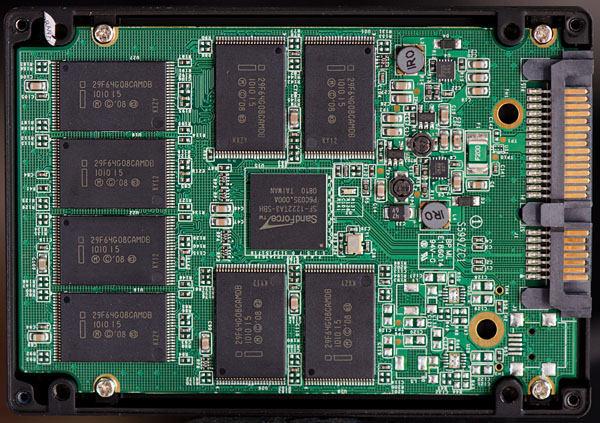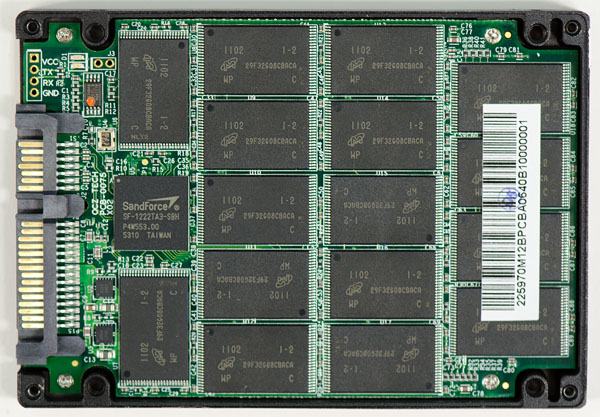The OCZ Vertex 3 Review (120GB)
by Anand Lal Shimpi on April 6, 2011 6:32 PM ESTThe Real Issue
While I was covering MWC a real issue with OCZ's SSDs erupted back home: OCZ aggressively moved to high density 25nm IMFT NAND and as a result was shipping product under the Vertex 2 name that was significantly slower than it used to be. Storage Review did a great job jumping on the issue right away.
Let's look at what caused the issue first.
When IMFT announced the move to 25nm it mentioned a doubling in NAND capacity per die. At 25nm you could now fit 64Gbit of MLC NAND (8GB) on a single die, twice what you could get at 34nm. With twice the density in the same die area, costs could come down considerably.

An IMFT 25nm 64Gbit (8GB) MLC NAND die
Remember NAND manufacturing is no different than microprocessor manufacturing. Cost savings aren't realized on day one because yields are usually higher on the older process. Newer wafers are usually more expensive as well. So although you get ~2x density improvement going to 25nm, your yields are lower and wafers are more expensive than they were at 34nm. Even Intel was only able to get a maximum of $110 decrease in price when going from the X25-M G2 to the SSD 320.
OCZ was eager to shift to 25nm. Last year SandForce was the first company to demonstrate 25nm Intel NAND on an SSD at IDF, clearly the controller support was there. As soon as it had the opportunity to, OCZ began migrating the Vertex 2 to 25nm NAND.
SSDs are a lot like GPUs, they are very wide, parallel beasts. While a GPU has a huge array of parallel cores, SSDs are made up of arrays of NAND die working in parallel. Most controllers have 8 channels they can use to talk to NAND devices in parallel, but each channel can often have multiple NAND die active at once.

A Corsair Force F120 using 34nm IMFT NAND
Double the NAND density per die and you can guess what happened next - performance went down considerably at certain capacity points. The most impacted were the smaller capacity drives, e.g. the 60GB Vertex 2. Remember the SF-1200 is only an 8-channel controller so it only needs eight devices to technically be fully populated. However within a single NAND device, multiple die can be active concurrently and in the first 25nm 60GB Vertex 2s there was only one die per NAND package. The end result was significantly reduced performance in some cases, however OCZ failed to change the speed ratings on the drives themselves.
The matter is complicated by the way SandForce's NAND redundancy works. The SF-1000 series controllers have a feature called RAISE that allows your drive to keep working even if a single NAND die fails. The controller accomplishes this redundancy by writing parity data across all NAND devices in the SSD. Should one die fail, the lost data is reconstructed from the remaining data + parity and mapped to a new location in NAND. As a result, total drive capacity is reduced by the size of a single NAND die. With twice the density per NAND die in these early 25nm drives, usable capacity was also reduced when OCZ made the switch with Vertex 2.
The end result was that you could buy a 60GB Vertex 2 with lower performance and less available space without even knowing it.

A 120GB Vertex 2 using 25nm Micron NAND
After a dose of public retribution OCZ agreed to allow end users to swap 25nm Vertex 2s for 34nm drives, they would simply have to pay the difference in cost. OCZ realized that was yet another mistake and eventually allowed the swap for free (thankfully no one was ever charged), which is what should have been done from the start. OCZ went one step further and stopped using 64Gbit NAND in the 60GB Vertex 2, although drives still exist in the channel since no recall was issued.
OCZ ultimately took care of those users who were left with a drive that was slower (and had less capacity) than they thought they were getting. But the problem was far from over.










153 Comments
View All Comments
jharmon - Monday, May 2, 2011 - link
It's been almost a month since an update in the SSD world from Anandtech. Are there any reviews on the near horizon? You said one might want to wait for a purchase until you got some of the lower capacity drives in to test to compare with the vertex 3.Thanks for all your hard work in analysis, Anand!
jharmon - Monday, May 2, 2011 - link
Maybe also address the issue with the hardware limitation from the Marvell controllers 91xx. If I understand it correctly, these will be be able to achieve the 500 MB/s. If that performance cannot be achieved, is the vertex 3 worth the premium?mrkimrkonja - Wednesday, May 4, 2011 - link
From these SSD articles I learned that TRIM is very important with SSD.I read somewhere that when you use SSD in RAID you lose TRIM support and some other things.
Is this true?
I now have 2 old ADATA SSD generation 1 in RAID0 they have 2x the performance comparing to a single drive bud they do not have TRIM anyway.
I already bought one VERTEX 2 60GB and thought buying anther one.
Always thought better more smaller disks in RAID than one big one.
If this is true I an thinking I would lose more over time without TRIM support than gain with RAID0.
Can you hal me with some info or first hand tests?
Foochey - Wednesday, May 4, 2011 - link
I would be very interested to see how the 480GB stacks up to these drives. Since these are parallel processing devices, you would think that the 480 would perform even better than the 240. Anand, any way you can get a 480 and test it? OCZ's specs look the same, so I'm guessing that they are using the smaller die chips or doing something with the way they write to the array. Any ideas? Price certainly makes the 480 out of the question for most of us, but I sure would be interested in its performance.jeffburg - Thursday, May 26, 2011 - link
OCZ Just launched the Max IOPS Version. Is that worth the extra $10? Whats the difference between the two?Palen - Thursday, June 2, 2011 - link
Thank you for another great article.In the conclusion of this article it's advised to wait for a couple of weeks to see how the vertex 3 120 GB goes againts the other 3rd generation 120GB SSD's. Is there any indication that Anandtech will be recieving / testing any of these drives in the near future?
Another thing is RAID: I've been doing some digging on SSD's, since I didn't know much about them untill last week. The general picture is starting to make sence now. Bigger is ussually faster (within certain parameters). However i'm getting conflicting information about RAID. According to some it's worth it, while others urge to stay away from RAID (no TRIM support, etc). It would be nice to have a well respected opinion in the mass of conflicting information. How would for instance 2x 60 GB SSD's do against a same type/brand 120 GB SSD? and how does the raidcontroller fit into this equation? On-board vs. professional solution?
My gut says "stay away from raid!" because the SSD's allready scale in performance depending on their storagesize. Next to that the strain that an onboard controller will put on your CPU. And paying for a professional raidcard just seems silly, with the range of SSD PCIe storage solutions. But than again, what do I know?
paul-p - Saturday, October 22, 2011 - link
After 6 months of waiting for OCZ and Sandforce to fix their firmware from freezes and BSOD's, I can finally say it is fixed. No more freezes, no more BSOD's, performance is what is expected. And just to make sure all of the other suggestions were 100% a waste of time, I updated the firmware and DID NOT DO anything else except reboot my machine and magically everything became stable. So, after all these months of OCZ and Sandforce blaming everything under the sun including:The CMOS battery, OROM's, Intel Drivers, Intel Chipsets, Windows, LPM, Hotswap, and god knows what else, it turns out that none of those issues had anything to do with the real problem, which was the firmware.
While I'm happy that this bug is finally fixed, Sandforce and OCZ have irrepairably damaged their reputation for a lot of users on this forum.
Here is a list of terrible business practices that OCZ and Sandforce have done over the last year...
OCZ did not stand behind their product when it was clearly malfunctioning is horrible.
OCZ did not allow refunds KNOWING that the product is defective is ridiculous.
OCZ nor Sandforce even acknowledged that this was a problem and steadfastly maintained it only affected less than 1% of users.
The fact that OCZ claims this bug affected 1% of users is ridiculous. We now know it affected 100% of the drives out there. Most users just aren't aware enough to know why their computer froze or blue screened.
OCZ made their users beta test the firmwares to save money on their own testing
OCZ did not have a solution but expected users to wipe drives, restore from backups, secure erase, and do a million other things in order to "tire out" the user into giving up.
OCZ deletes and moves threads in order to do "damage control and pr spin".
But the worst sin of all is the fact that it took almost a year to fix such a MAJOR bug.
I really hope that OCZ learns from this experience, because I'm certain that users will be wary of Sandforce and OCZ for some time. It's a shame, because now that the drive works, I actually like it.
paul-p - Saturday, October 22, 2011 - link
I just want to thank Anandtech for being the ONLY site out there there called out OCZ and Sandforce for having defective products. While every other hardware site out there were kissing OCZ and Sandforces butt and saying that the Vertex 3 SSD was the best thing since sliced bread, Anandtech actually was one of the only sites that actually acknowledged that there was a major bug with the sandforce controllers.I can't believe all the review sites out there were praising the Vertex 3 for almost a year when the drive had major BSOD and freezing issues. A review should be more than running a benchmark on the drive, but checking to see how the drive performs and making sure it is stable. In my eyes, every other review site showed me that they care more about the sponsors and advertising dollars than the users that visit their site. So, once again, thanks Anandtech for speaking the truth when others wouldn't.
danwat12345 - Sunday, November 13, 2011 - link
I think I'll keep my 80GB Intel X25-m G2 SSD. From your benchmarks it looks like the 120GB Vertex 3 over SATA 2 isn't that much better with random read operations than my trusty ole' 80GB Intel.I am curious if your Anandtech storagebench 2011 test were done on completely in-compressible data? The random read numbers of the Vertex 3 120GB SATA2 drive wasn't very impressive.
chainspell - Saturday, December 10, 2011 - link
you had me at page 4...tell Alex Mei (the CEO) he has my business, I just bought 2 of these on Newegg!